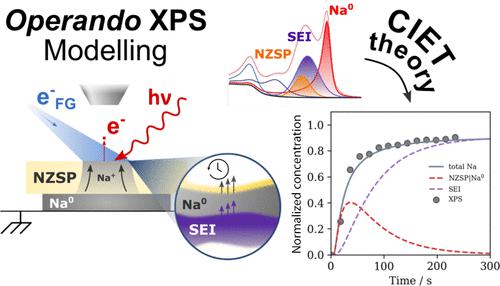当前位置:
X-MOL 学术
›
Chem. Mater.
›
论文详情
Our official English website, www.x-mol.net, welcomes your
feedback! (Note: you will need to create a separate account there.)
Operando Characterization and Theoretical Modeling of Metal|Electrolyte Interphase Growth Kinetics in Solid-State Batteries. Part II: Modeling
Chemistry of Materials ( IF 7.2 ) Pub Date : 2023-01-28 , DOI: 10.1021/acs.chemmater.2c03131 Nicholas J Williams 1, 2 , Edouard Quérel 1 , Ieuan D Seymour 1 , Stephen J Skinner 1 , Ainara Aguadero 1, 3
Chemistry of Materials ( IF 7.2 ) Pub Date : 2023-01-28 , DOI: 10.1021/acs.chemmater.2c03131 Nicholas J Williams 1, 2 , Edouard Quérel 1 , Ieuan D Seymour 1 , Stephen J Skinner 1 , Ainara Aguadero 1, 3
Affiliation

|
Understanding the interfacial dynamics of batteries is crucial to control degradation and increase electrochemical performance and cycling life. If the chemical potential of a negative electrode material lies outside of the stability window of an electrolyte (either solid or liquid), a decomposition layer (interphase) will form at the interface. To better understand and control degradation at interfaces in batteries, theoretical models describing the rate of formation of these interphases are required. This study focuses on the growth kinetics of the interphase forming between solid electrolytes and metallic negative electrodes in solid-state batteries. More specifically, we demonstrate that the rate of interphase formation and metal plating during charge can be accurately described by adapting the theory of coupled ion-electron transfer (CIET). The model is validated by fitting experimental data presented in the first part of this study. The data was collected operando as a Na metal layer was plated on top of a NaSICON solid electrolyte (Na3.4Zr2Si2.4P0.6O12 or NZSP) inside an XPS chamber. This study highlights the depth of information which can be extracted from this single operando experiment and is widely applicable to other solid-state electrolyte systems.
中文翻译:

固态电池中金属|电解质界面生长动力学的操作表征和理论建模。第二部分:建模
了解电池的界面动力学对于控制降解、提高电化学性能和循环寿命至关重要。如果负极材料的化学势位于电解质(固体或液体)的稳定窗口之外,则会在界面处形成分解层(界面)。为了更好地理解和控制电池界面的退化,需要描述这些界面形成速率的理论模型。本研究重点研究固态电池中固体电解质和金属负极之间形成界面的生长动力学。更具体地说,我们证明通过采用耦合离子电子转移(CIET)理论可以准确描述充电过程中相间形成和金属电镀的速率。该模型通过拟合本研究第一部分中提供的实验数据进行了验证。当将 Na 金属层镀在 XPS 室内的 NaSICON 固体电解质(Na 3.4 Zr 2 Si 2.4 P 0.6 O 12或 NZSP)顶部时,收集数据。这项研究强调了可以从这个单一操作实验中提取的信息的深度,并且广泛适用于其他固态电解质系统。
更新日期:2023-01-28
中文翻译:

固态电池中金属|电解质界面生长动力学的操作表征和理论建模。第二部分:建模
了解电池的界面动力学对于控制降解、提高电化学性能和循环寿命至关重要。如果负极材料的化学势位于电解质(固体或液体)的稳定窗口之外,则会在界面处形成分解层(界面)。为了更好地理解和控制电池界面的退化,需要描述这些界面形成速率的理论模型。本研究重点研究固态电池中固体电解质和金属负极之间形成界面的生长动力学。更具体地说,我们证明通过采用耦合离子电子转移(CIET)理论可以准确描述充电过程中相间形成和金属电镀的速率。该模型通过拟合本研究第一部分中提供的实验数据进行了验证。当将 Na 金属层镀在 XPS 室内的 NaSICON 固体电解质(Na 3.4 Zr 2 Si 2.4 P 0.6 O 12或 NZSP)顶部时,收集数据。这项研究强调了可以从这个单一操作实验中提取的信息的深度,并且广泛适用于其他固态电解质系统。









































 京公网安备 11010802027423号
京公网安备 11010802027423号